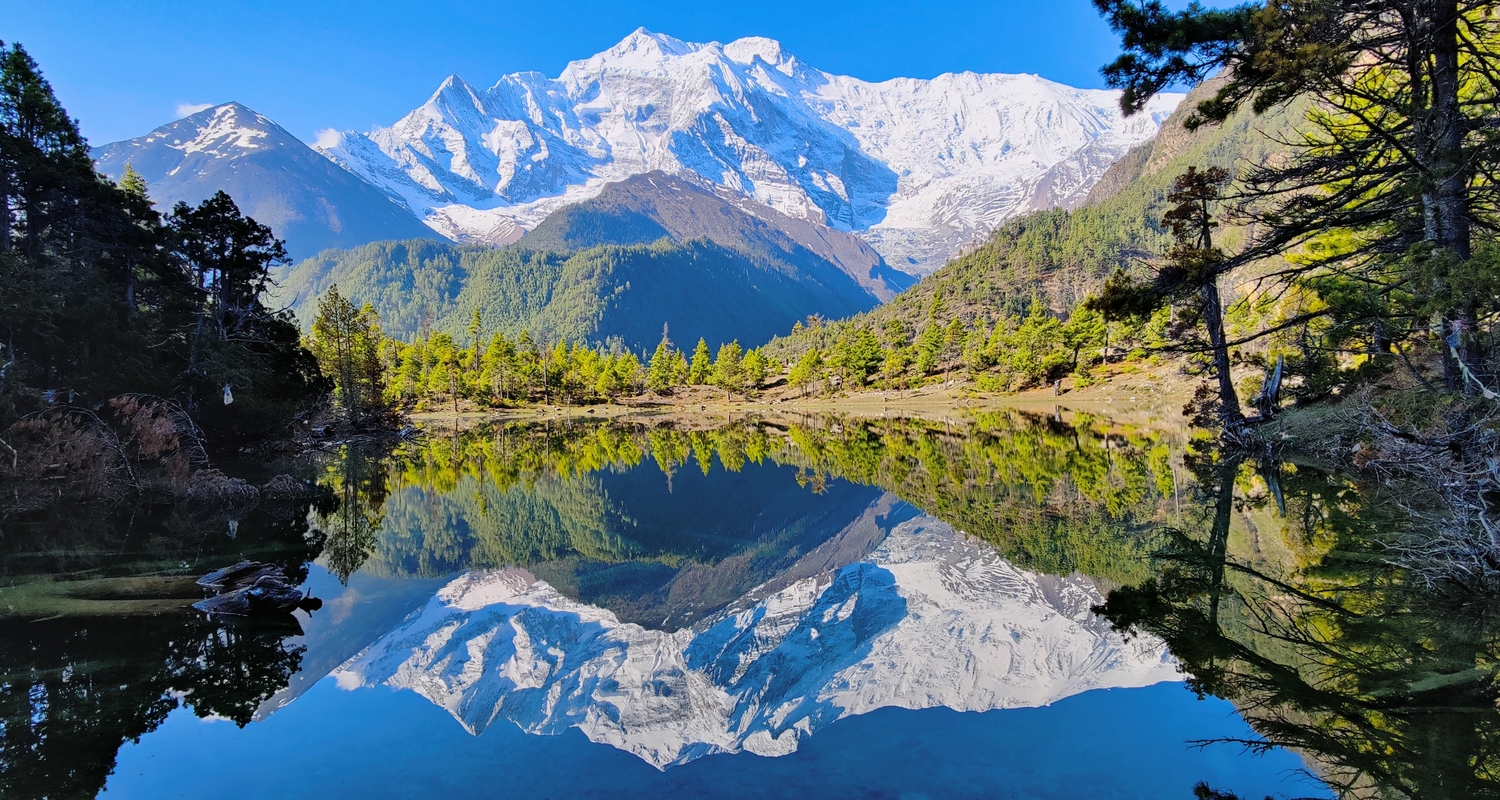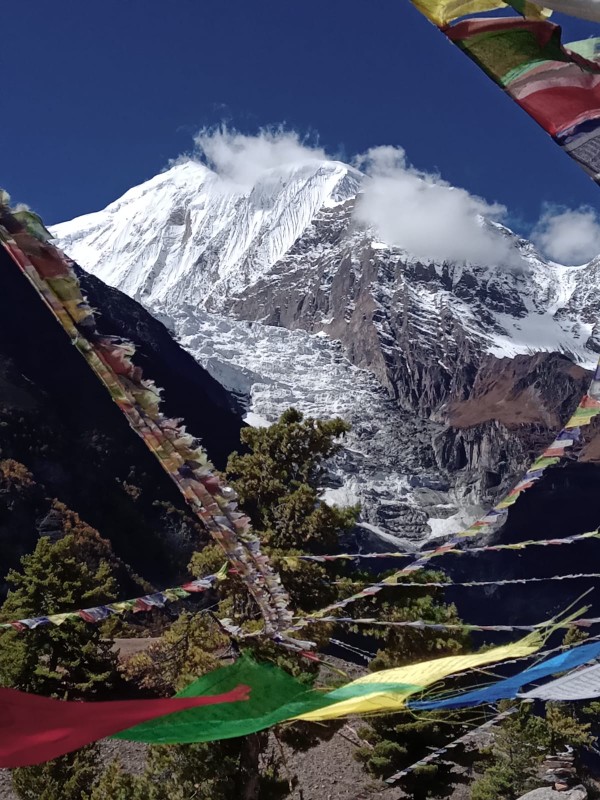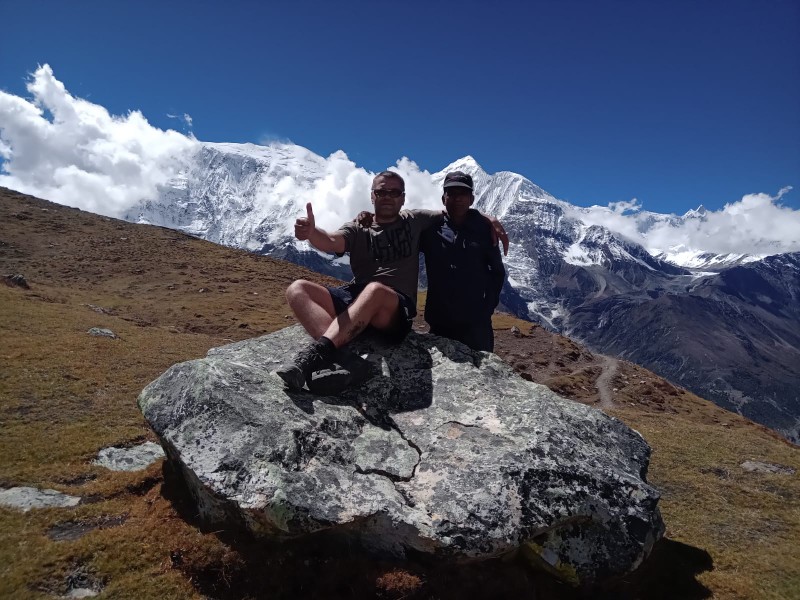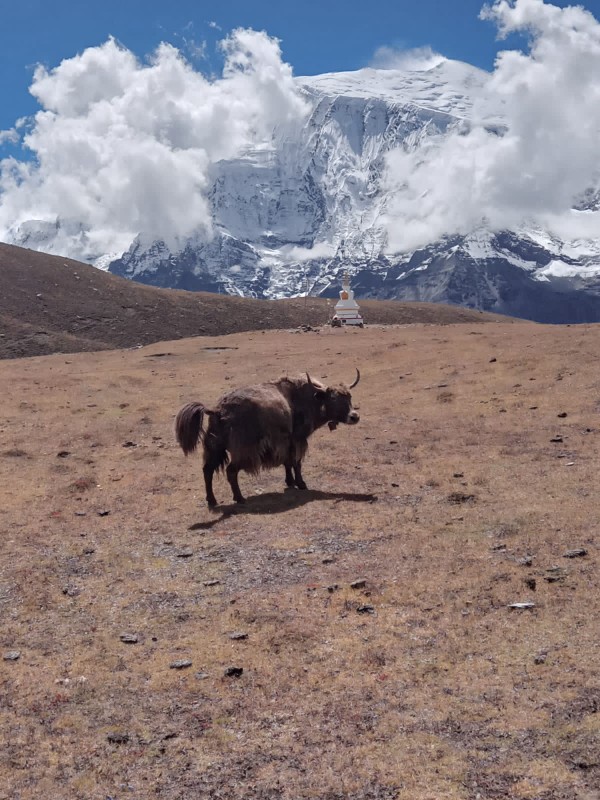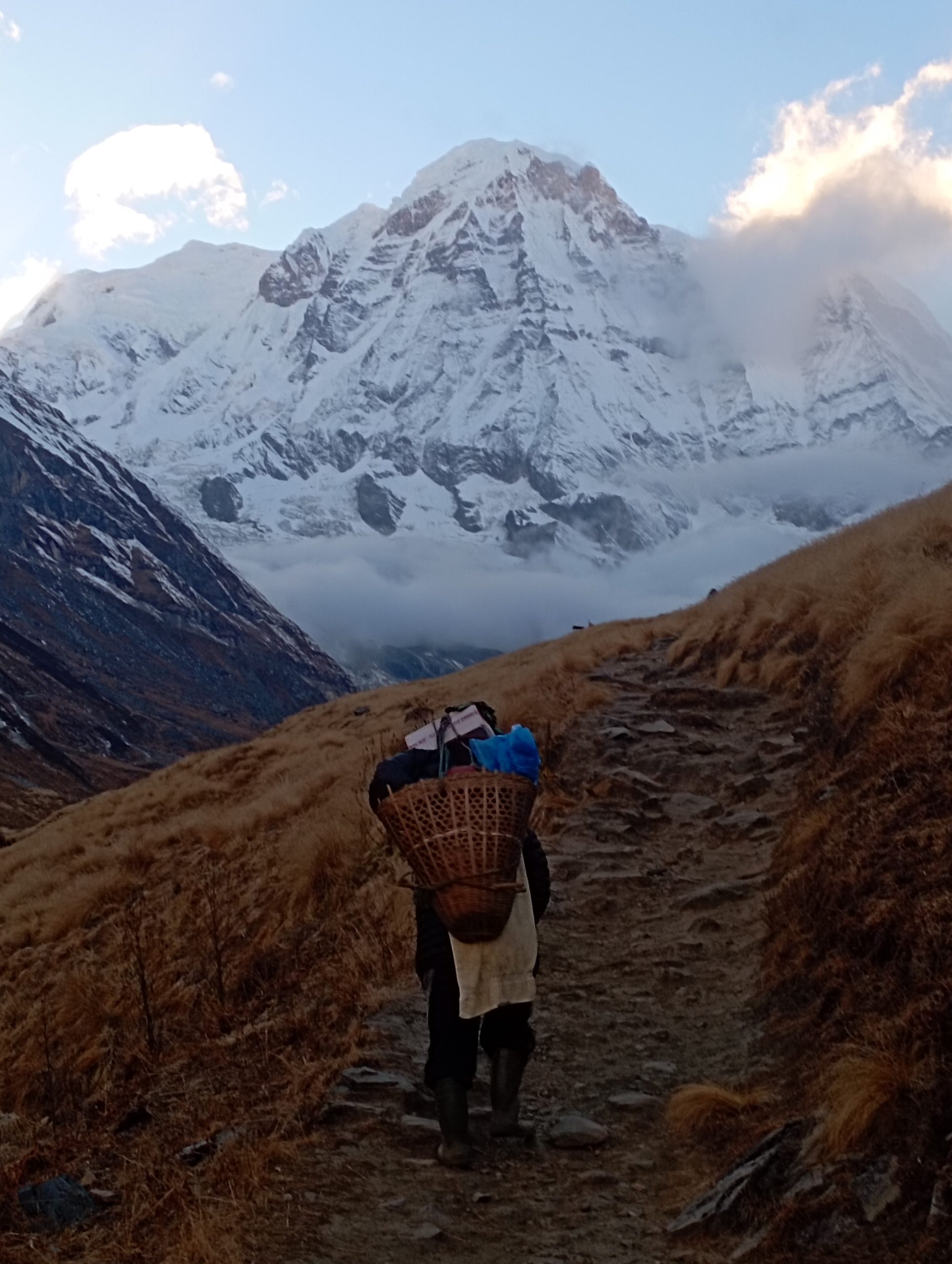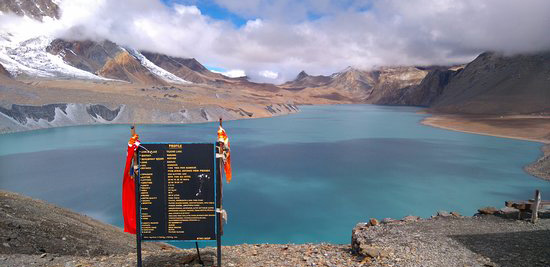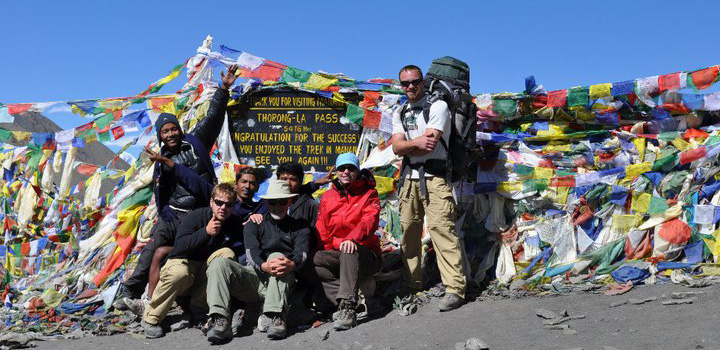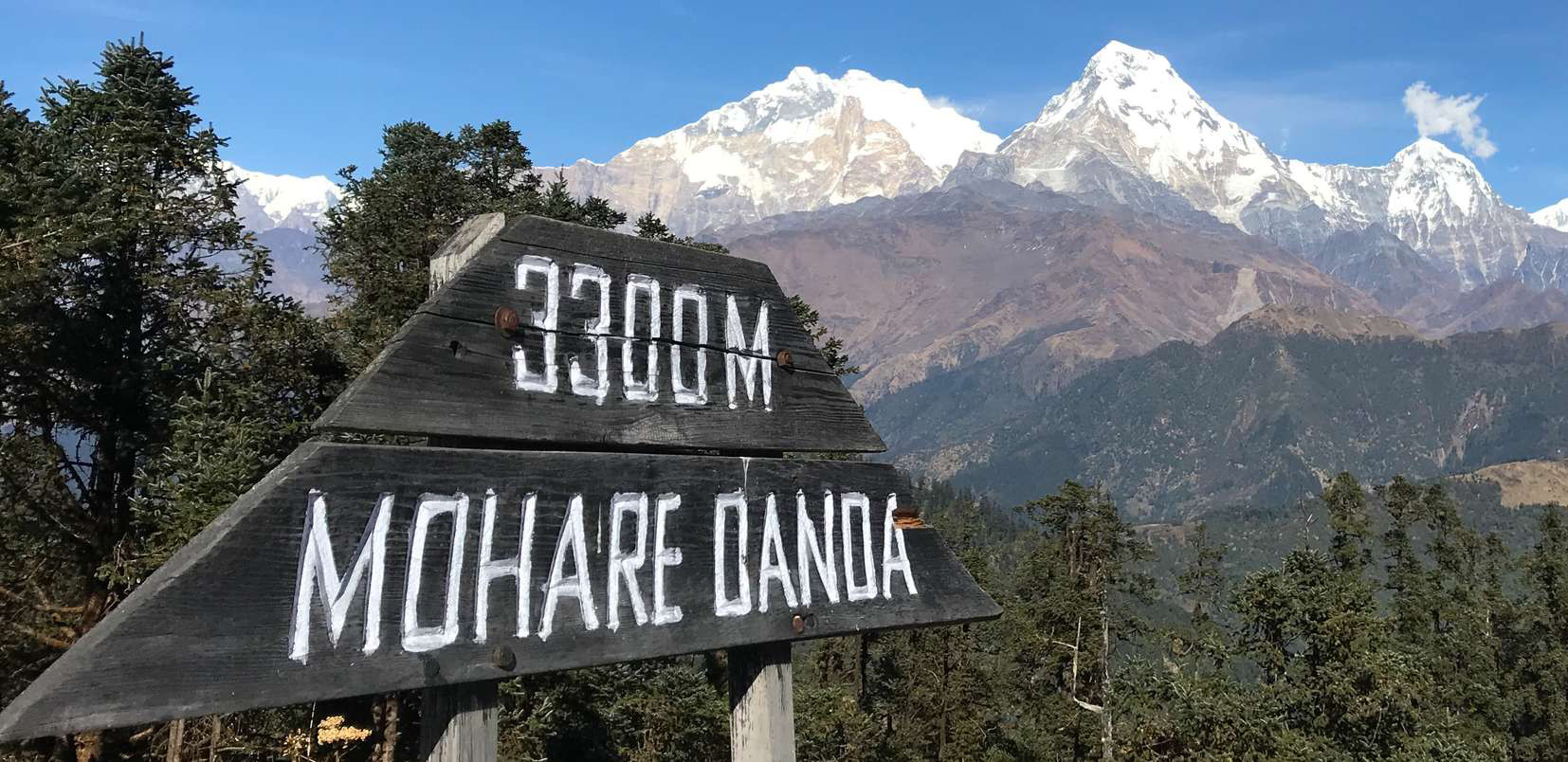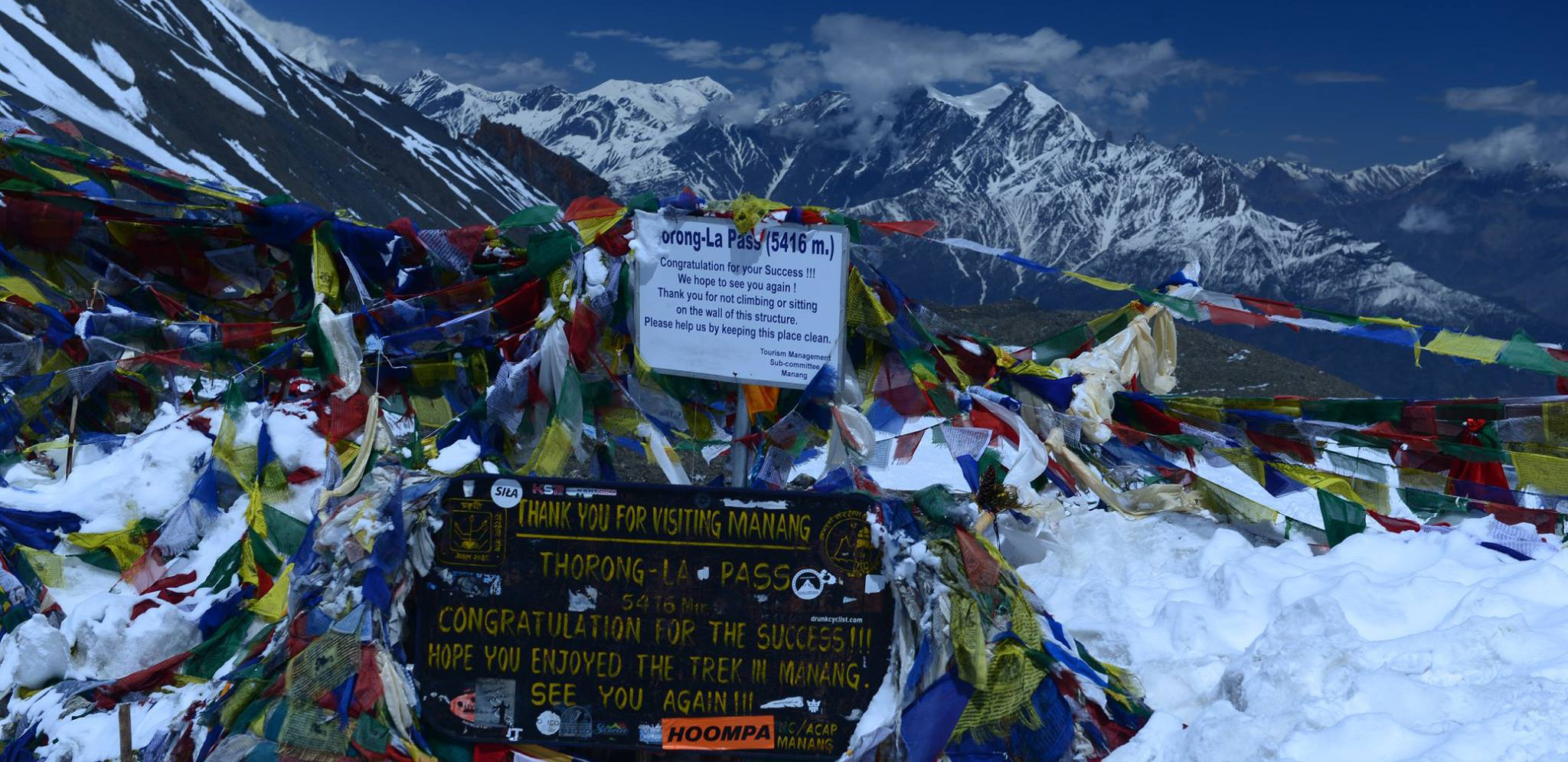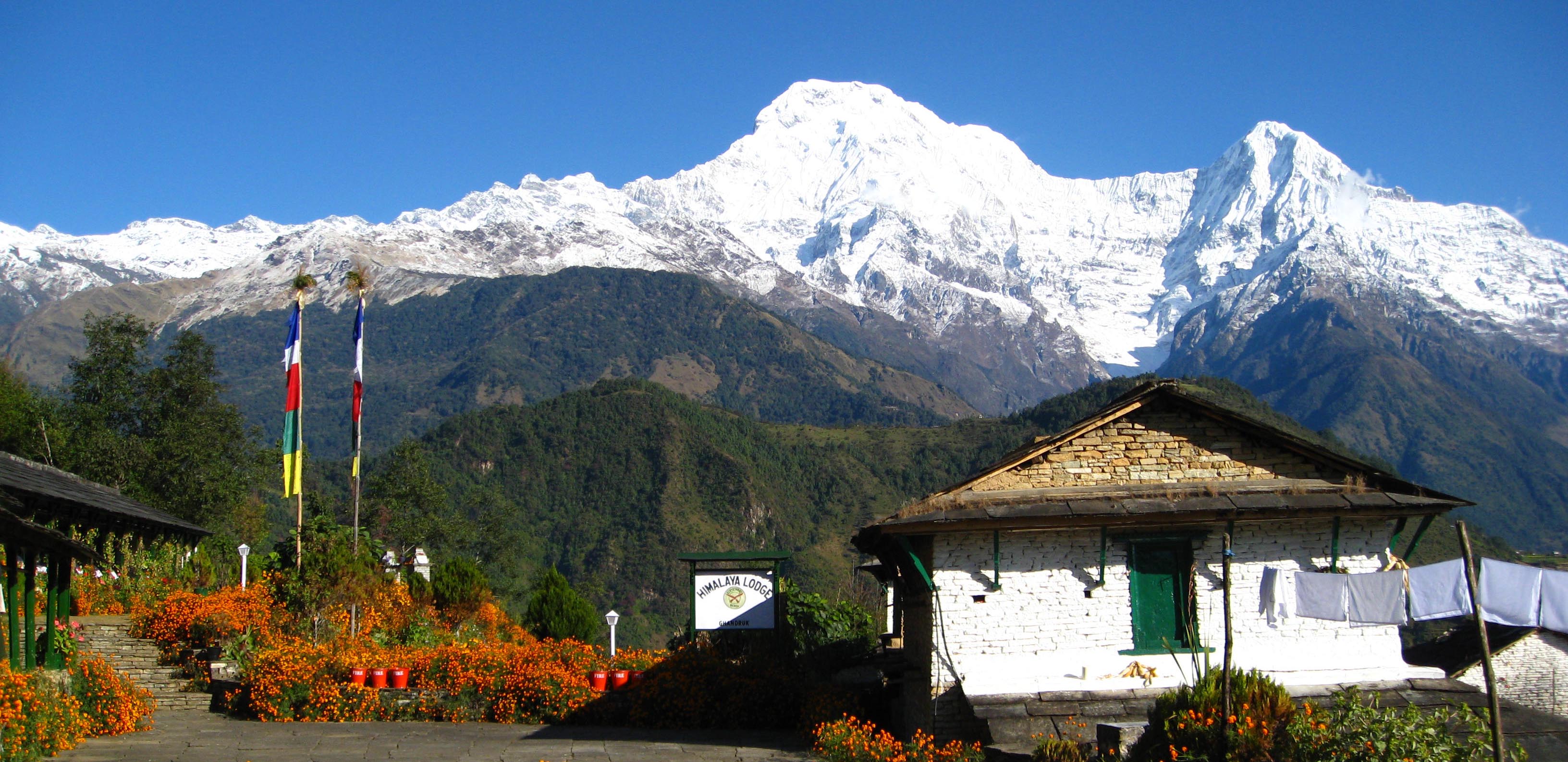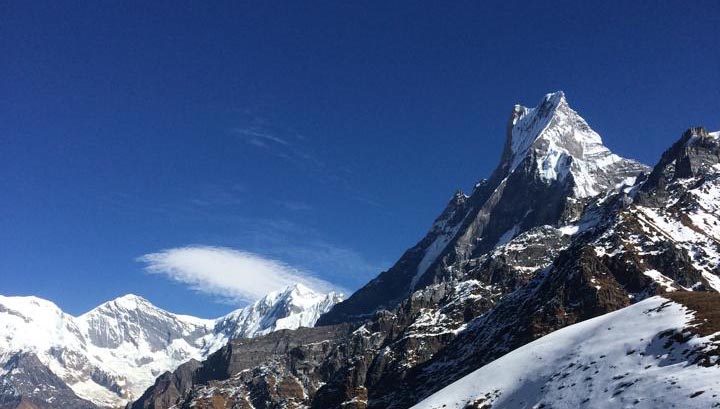Annapurna Circuit Trek
Annapurna Circuit Trek completes the round journey of the Annapurna Mountain Range in the Annapurna Region, of Nepal. The trail rises to an altitude of 5,416m on the Thorung La Pass, touching the edge of Tibet. This trek crosses Thorung La (5416m/17769 ft.) which is the highest pass on this trek. This trek provides a lifetime opportunity to explore the diverse culture, religions, typical villages, beautiful landscapes, valleys, green hills, subtropical forests, paddy fields, gigantic cliffs, artistic waterfalls, tranquil lakes, pristine rivers, gorges, temples, monasteries, Gompas. It also provides fantastic views of Annapurna (8091m), Dhaulagiri (8168m), Machhapuchhre (6993m), Nilgiri (7061m) and Himchuli (6441m. The diverse culture of different ethnic groups such as Brahmin, Chhetri, Gurung, Magar, Thakali, and Tibetan Buddhists are the main attraction of this trek. Annapurna Circuit Trek is also the best long-distance trek in the world.
Day 01: Arrival in Kathmandu (1,300m/4,264ft)
Day 02: Kathmandu Sightseeing and trek preparation
Day 03: Drive from Kathmandu to Syange (1100 meter)
Day 04: Syange to Dharapani (1,860m / 6,200ft)(5 – 6 hrs)
Day 05: Dharapani to Chame(2,610m / 8,890ft) Duration:4- 5 hours
Day 06: Chame to Pisang(3300m) Duration: 5 hours
Day 07: Pisang to Manang (3570m) Duration: 4 hours
Day 08: Manang – Rest day to acclimation
Day 09: Manang to Yak Kharka (4195m), (4 – 5hrs)
Day 10: Trek Yak Kharka to Phedi (4430m), (4 to 5hrs)
Day 11: Trek Phedi to Thorong-La (Pass), (5416m) and Muktinath (3802m), (7– 9hrs)
Day 12: Trek from Muktinath to Jomasom, (5 – 6 hrs)
Day 13: Fly from Jomsom to Pokhara, (30min)
Day 14: Fly Back to Kathmandu. ( 30 min)
Day 15: Departure Day
Day 01: Arrival in Kathmandu (1,300m/4,264ft)
One of the representatives from Himalayan Sanctuary Adventure welcomes you from the International Airport and transfers you to your hotel in Kathmandu. Stay overnight in a hotel room.
Day 02: Kathmandu Sightseeing and trek preparation
In the morning, you proceed Sightseeing in some places as given below:
- Boudhanath Stupa:
The largest stupa and center of Tibetan Buddhism in the Kathmandu valley. One of the best places to relax and take a hint of Buddhist culture is in Kathmandu. - Pashupatinath Temple:
The Pashupatinath Temple is one of the most significant Hindu temples in Asia with over 500 small and big shrines, Lingams, and temples in the temple complex. - Patan Durbar Square:
Patan Durbar Square is an intriguing blend of palace structures, artistic courtyards, and elegant pagoda temples. Among its main attractions is the 17th-century Krishna Mandir (Temple). The Patan Museum contains bronze statues and other religious objects which has great significance. Durbar Square has both religious and cultural importance and the surroundings are artistically beautiful. - Swayambhunath Stupa:
Also known as the ‘Monkey Temple’, this is one of the oldest heritage sites in Nepal. From the top viewpoint, you will have an amazing view of the capital city “Kathmandu”.
Day 03: Drive from Kathmandu to Syange/Jagat (1100m) 7 – 9 hours
Early wake up in the morning, and drive to Beshisahar by local bus. Then drive to Syange by local Jeep for 8/9 hours through Trishuli and Marshangdi River (famous River for rafting) and village countryside. Some insight into the rural people’s lifestyle and their culture on this drive. From Syange, we begin our trek. We’ll walk to Jagat. Stay overnight at the lodge. Breakfast, lunch, and dinner are included.
Day 04: Jagat to Dharapani (1,860m / 6,200ft) 4 – 6 hours
We reach Chyamje from Jagat and walking further we cross a suspension bridge that takes us uphill through the Oak forest. We proceed further to reach Kodo village and then from there ascend to reach Dharapani. Stay overnight at a Guesthouse. Breakfast, lunch, and dinner are included.
Day 05: Dharapani to Chame (2,610m / 8,890ft) 4 – 5 hours
Enjoy the trail, climbs along the mule track into a fir forest, and cross the river surrounded by higher oak and maple trees. Admire the awesome views of major Himalayan peaks on the way and walking further you reach Chame. Stay overnight at Guesthouse. Breakfast, lunch, and dinner are included.
Day 06: Chame to Pisang (3300m) 4 – 5 hours
Passing through a steep and narrow river valley in dense woodland on our trail. The spectacular view of Pisang Peak and Annapurna II on our way is fantastic. Stay overnight at a Guesthouse. Breakfast, lunch, and dinner are included.
Day 07: Pisang to Manang (3570m) Duration: 4 hours
We trek to Manang vupper route via Ghyaru, Ngawal and Mungji. The panoramic views of Annapurna, Pisang Peak, and several other peaks are breathtaking upon reaching the top. The view of the change in topography as we reach here and a memorable short visit the largest Barge monastery of that district. Stay overnight at a Guesthouse. Breakfast, lunch, and dinner are included.
Day 08: Manang (Rest day to acclimatize)
Today is acclimatization day so it would be easier to proceed further to the higher altitude. Tour around monasteries with a side trip to Lake Gangapurna. Visit the Himalayan Rescue clinic and nearby local villages and interact with them. Learn about their culture and tradition and stay overnight at a guesthouse. Breakfast, lunch, and dinner are included.
Day 09: Trek Manang to Yak Kharka (4195m), (4 – 5hrs)
We ascend to the Tenki village and then climb out of the Marshyangdi valley up to the Jarsang Khola. Passing through pasturelands, Juniper trees, and Ghunsa village witnessing yaks and horses grazing to reach the beautiful village of Yak Kharka. We cross a wooden bridge and pass through the ancient Mani wall and finally reach Yak Kharka. Stay overnight there– breakfast, lunch, and dinner included.
Day 10: Trek Yak Kharka to Phedi (4430m), (4 to 5hrs)
We pass through the busy settlement of Thorong Phedi to the point where many trekkers used it as a base camp. We stop at Thorong Phedi as our next day trekking is tough and to get proper acclimatization we stay overnight here. Breakfast, lunch, and dinner are included.
Day 11: Trek Phedi to Thorong-La (Pass), (5416m) and Muktinath (3802m), (9 – 10hrs)
Walk through a steep ascent and rocky ridges to reach the top of the peak which is slightly icy from melting snow. The stunning views of snow-capped mountains from the top including the Annapurna Ranges. The beautiful Kali Gandaki gorge as we continue our trail and descend downhill to reach the holy Hindu pilgrimage Muktinath (3800m). Many Tibetan ethnics and Buddhist devotees reside here. Stay overnight there – Breakfast, lunch, and dinner included.
Day 12: Muktinath to Jomsom (2600m) 5- 6 hours
We complete our Annapurna Circuit Trek after visiting the sacred Muktinath temple and trekking further to Jomsom. Stay overnight at Jomsom.
Day 13: Flight from Jomsom to Pokhara (25 min)
An adventurous 25-minute morning flight to Pokhara from Jomsom. Rest and relax for a while in a hotel. Rest of the day tour nearby places or visit local markets if you wish to. Enjoy the nightlife in Pokhara. Stay overnight at a hotel.
Day 14: Fly Back to Kathmandu.
We fly back to Kathmandu in the morning. Rest and relax for a while. You can tour nearby places if you wish to. Stay overnight in Kathmandu.
Day 15: Departure Day
Our driver see off you at the International Airport for the final departure. Best wishes for your journey onward to the next destination.
Note: Above itinerary can be designed to your preferences. Please let us know whether you would like to make a shorter or longer.
What Is Included
- Pickups and drops from hotels and airport
- 3-star Category hotels Accommodations in Kathmandu and Pokhara including Breakfast
- Private Transportation to the trekking starting Point
- Jomsom to Pokhara flight
- Kathmandu Heritage Sites Sightseeing(4 – 6hr)
- Teahouse/Lodge Accommodation including Breakfast, Lunch, and Dinner during the trek
- Farewell dinner at the end of Trek
- Himalayan Sanctuary Adventure Duffel Bag
- An experienced English-speaking Trekking guide, and porters to carry luggage (2 trekkers: 1 porter) including their salary, insurance, equipment, flight, food, and lodging
- All necessary paperwork and permits (ACAP, TIMS )
- A comprehensive medical kit
- All government and local taxes
What Is Excluded
- Nepalese visa fee
- International airfare to and from Kathmandu
- Excess baggage charges
- Entrance fees for Sightseeing and Tour Guide
- Lunch and dinner in Kathmandu and/or Pokhara
- Extra night accommodation in Kathmandu and Pokhara in case of early arrival, late departure, and early return from the mountain(due to any reason) than the scheduled itinerary
- Travel and rescue insurance
- Personal expenses (phone calls, laundry, bar bills, battery recharge, extra porters, bottle or boiled water, Tea, Coffee, Wi-Fi, hot shower, etc.)
- Tips for guides and porters
Our main paramount is to offer a safe and enjoyable trek for your clients. Experienced trekkers will often take only a selection of these items based on what has worked in the past. The following gives you a general idea of the personal items that you need to bring for the trek. The personal items are of individual interest and choice. The most important fact that one should keep in mind is that one should have enough clothes to tackle the cold weather in the Himalayas.
Upper Body – Head / Ears / Eyes
- Sun hat (We provide you a complimentary sunhat)
- Wool or synthetic hat that covers the ears
- Sunglasses with UV protection
- Headlamp
- Neck warmer
Hand
- Liner gloves
- Heavier shell gloves
Core Body
- T-shirts (2)
- Lightweight expedition thermal tops
- Fleece jacket or pullover
- Water/windproof shell jacket (Preferably breathable fabric)
- Synthetic sports bras (for women)
Lower Body – Legs
- Lightweight expedition thermal bottoms
- Nylon hiking shorts
- Soft shell and hard shell trekking pants
- Water/windproof trousers
- Casual pants
Feet
- Liner socks
- Heavyweight socks
- Waterproof hiking/trekking boots
- Light shoes/sneakers
- Gaiters (For monsoon and winter)
Other essential important items
- Passport and extra passport photos (2 copies)
- Airline tickets (Please make a copy and leave one at our office in Kathmandu just in case you need to change the date of yours)
- Durable wallet/pouch for travel documents, money & passport
- Water bottle/bladder
- Water purification Iodine tablets
- Toiletries (Include toilet paper, wet wipes, and liquid hand sanitizer, towel, soap)
Medicines and First Aid Kit
- Extra Strength Excedrin for altitude-related headaches
- Ibuprofen for general aches and pains
- Immodium or Pepto bismol capsules for upset stomach or diarrhea
- Diamox (commonly prescribed as Acetazolamide) 125 or 250mg tablets for altitude sickness
- Anti-infection ointments
- Band-aids
- Lip balm (At least SPF 20)
- Sunscreen (SPF 40)
Optional
- Adjustable trekking poles
- Favorite snacks (No more than 2 pounds)
- Paperback books, cards, mp3 player.
- Binoculars
- Cameras (Memory cards, chargers, and batteries)
- Pee bottle for man and pee funnel for woman
Note: This equipment list is only a guide. You need to bring the listed items, however, you can choose from your preferred brands using your expertise. Plus, you can shop the trekking equipment and clothing at a reasonable price at stores in Thamel, Kathmandu.
Will somebody come to pick me up at the airport upon my arrival?
Yes, Our representative from Himalayan Sanctuary Adventure will be waiting for you outside the airport terminal. Upon arrival, you will be transferred to your hotel for an overnight in Kathmandu.
Can I obtain a visa for Nepal on arrival at the airport?
YES, you can obtain the visa easily upon your arrival at Tribhuvan International Airport in Kathmandu (Tourist Visa with Multiple Entries for 15 days can be obtained by paying USD 30 or equivalent foreign currency. Similarly, a Tourist Visa with Multiple Entries for 30 days and 90 days can be obtained by paying USD 50 and 125 respectively. Please bring 2 copies of passport-size photos.)
Can I use credit cards in the places I visit in trekking?
Once you are out of the cities, all you need is cash. Please change the currency to local Nepali Rupees before you go to the mountains.
I am a Vegetarian, is that a Problem?
No problem at all because mostly, the lodges serve vegetarian meals. We always recommend our clients t eat vegetarian meals to avoid food poisoning, eating heavy meals and non-vegetarian meals at high altitudes is not safe for the stomach.
Do I need to bring toilet paper for the trek?
Almost all the guest houses sell toilet paper so you can buy it there. Hand sanitizer and a towel you must bring your own.
Where do we go to the toilet along the trail?
In most cases, you can use the toilet provided by the tea houses/lodges on the trail but normally in case of emergency, you just do the toilet along the trail wherever you find privacy.
What sort of accommodation can I expect in Kathmandu, Pokhara, and trekking?
We use standard rooms at 2-star category hotels in Kathmandu and Pokhara with breakfast. Along the trekking routes, Teahouses/lodges generally provide basic clean facilities with a mattress and a quilt or blanket. The lodges in trekking routes usually provide single and double rooms, or occasionally a dormitory style. At times when possible, dining will be around a bonfire. In teahouses, food will be prepared in the kitchen, which you should not enter without permission. The toilet in teahouses provides essential and basic facilities and is always outside the room.
What is the drinking water facility in the mountain?
Bottled water is easily available at the lodges and teahouses, which you can buy at the cost of USD 1 at lower elevations up to USD 4 to higher elevations per liter.
If you are planning to drink normal water during trek, purifying water with any sort of purification tablets or drops is a must. You can bring your purifier or can purchase it in Kathmandu.
How much additional money do I need per day?
It depends on your spending habits. Generally, in Kathmandu and Pokhara, you can allocate USD 10 to USD 15 for lunch and dinner. USD 10 to USD 15 per person a day will be enough to buy bottles of water, and chocolates, pay for the hot shower, and a few drinks during the trekking.
What is the weather & temperature like in trekking?
One of the most unpredictable elements of the mountain is the weather. If you’re not properly prepared for the twists, turns, and volatility of the conditions that can occur in this breathtaking region, you might find yourself in an uncomfortable and unpleasant situation.
Spring – March / April / May / June
During springtime, the average temperature is 20 degrees C (68 Degrees F), with a maximum of 25 degrees C (77 Degrees F), during sunny days and a minimum of 0 degrees C (32 Degrees F), in the morning and at night for areas above 2500 meters.
July / August Through Mid- September is Monsoon Season
This season is not recommended to travel as it rains in the lower altitudes. There are positive sides to trekking during the monsoon months as the excess rainfall can provide ample chance to see spectacular views of the waterfall and it’s also the best season to avoid the crowds.
During this time, the average temperature is 25 degrees C (77 Degrees F), with a maximum of 30 degrees C (86 Degrees F), during sunny days and a minimum of 5 degrees C (41 Degrees F), in the morning and at night for areas above 2500 meters.
Autumn – End of September / October / November
The average temperature during the fall is 20 degrees C (68 Degrees F), with a maximum temp of 25 degrees C (77 Degrees F), during sunny days and a minimum of -5 degrees C (23 Degrees F), in the morning and at night, for areas above 2500 meters altitude.
Winter- December/ January/ February
Winter starts from mid December till mid-February in this region. The average temperature during the winter is 10 degrees C (50 Degrees F), with a maximum temp of 17 degrees C (62.6 Degrees F), during sunny days and a minimum of -10 degrees C (14 Degrees F), in the morning and night, for areas above 2500 meters altitude.
The above temperature is based on the outside of the guesthouse temperature. No need to worry about the cold temperature as we provide the sleeping bag plus the extra blanket to make sure our clients are warm enough during their time of need.
What is the temperature rating of the sleeping bag that you lend to trekkers?
The temperature rating of the sleeping bags we provide is about -10 degrees C (14 Degrees Fahrenheit), our guide can provide a liner or extra blanket from the lodge in the mountain if the sleeping bag is not warm enough for you.
Do your guides have trekking guide certificates from the Hotel Management and Tourism Center? Have they received first aid training for high altitude?
Yes, they have all received a 45-day training from the Hotel Management and Tourism Center in Nepal. The guides have also received high-altitude first aid training from KEEP (Kathmandu Environmental Education Project).
What immunizations will I need?
You don’t need to submit any immunization documents to enter Nepal however if you have been immunized with diphtheria TB, hepatitis A, hepatitis B, malaria, typhoid, polio, and tetanus then that is a plus point but it’s not mandatory. We also recommend: A dental check-up before travelling. You know your blood group in case of emergency
If I am sick can I continue the trek the next day after a day’s rest?
It depends on the level of your sickness. Once you are sick at a higher altitude you need to rest at a lower altitude and you at least need 3 days to a week for recovery.
If you are on private or solo trip you can discuss and decide with a guide depending on your health status.
If you were in-group then this option would be limited so please make sure you discuss with a guide and catch up with the group later on.
Is there any communication while we are on trekking?
There are telephones in some villages along the trekking routes. Our guides are equipped with the local mobile phone. They carry the Nepal Telecom and Ncell Sim that has good network coverage.
Can I charge my digital camera or other equipment on my trip?
These facilities will be available in most of the places in your hotel reception by paying some service charges. Remember to bring TWO and THREE-pin travel adapters! You can also buy the adapters in supermarkets or electronic shops in Kathmandu. Our guide can help you with it.
Do you use yaks/porters on the trek or do we carry all of our gear?
While on the trek, our porter will take care of your luggage. All you need to carry is your small day bag for your personal belongings like a camera, water bottle, sun cream, etc.
Will there be a place to store items/clothing not required for the trek?
The hotel in Kathmandu does provide free storage services. So you can leave all your items that are not required for the trekking at your hotel.
Do I need to tip my guide and porters? How much would that be?
This is a difficult thing to gauge. We have seen everything from USD 20 to USD 100 per person for guides and porters. Tipping is not required, but a small gesture of thanks to your guides and local porters. The level of the tip should reflect the level of satisfaction from and personal involvement with your guide. However, we recommend you spend a minimum of 10% of your total trip cost for tipping the entire local staff.
| Start Date | End Date | Price in USD | Availability | Booking | Note |
|---|
Avabillity Options
OPEN: This date is available and open for bookings. Go for it!
GUARANTEED: Guaranteed departure. Seat Available.
LIMITED: Guaranteed departure, Limited seat. You can send booking request for availability.
FULL:This date is currently unavailable. Please contact us if you are interested in traveling on this date.


